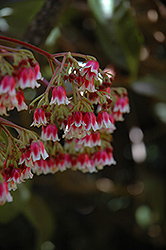It's all about ...
plants

Height: 20 feet
Spread: 15 feet
Sunlight:
![]()
![]()
Hardiness Zone: 8b
Other Names: Synardisia venosa
Description:
A first rate accent tree adorned with frothy panicles of scarlet red and white flowers in early summer; interesting steel-gray bark and a dense, upright habit, an ideal choice for small home landscapes; needs full sun and well-drained soil
Ornamental Features
Coralberry Tree features dainty clusters of scarlet bell-shaped flowers with white edges at the ends of the branches in mid spring. It features an abundance of magnificent coral-pink berries in mid fall. It has dark green evergreen foliage which emerges coppery-bronze in spring. The glossy pointy leaves remain dark green throughout the winter.
Landscape Attributes
Coralberry Tree is a dense multi-stemmed evergreen tree with an upright spreading habit of growth. Its relatively fine texture sets it apart from other landscape plants with less refined foliage.
This tree will require occasional maintenance and upkeep, and is best pruned in late winter once the threat of extreme cold has passed. It has no significant negative characteristics.
Coralberry Tree is recommended for the following landscape applications;
- Shade
- Mass Planting
- Hedges/Screening
- General Garden Use
Planting & Growing
Coralberry Tree will grow to be about 20 feet tall at maturity, with a spread of 15 feet. It has a low canopy with a typical clearance of 2 feet from the ground, and is suitable for planting under power lines. It grows at a medium rate, and under ideal conditions can be expected to live for 40 years or more.
This tree does best in full sun to partial shade. It does best in average to evenly moist conditions, but will not tolerate standing water. It is particular about its soil conditions, with a strong preference for rich, acidic soils. It is somewhat tolerant of urban pollution. This species is not originally from North America.
This plant is not reliably hardy in our region, and certain restrictions may apply; contact the store for more information.
